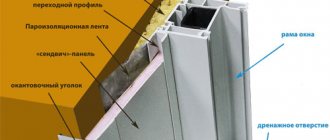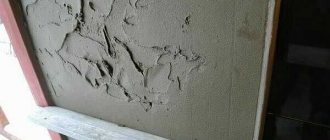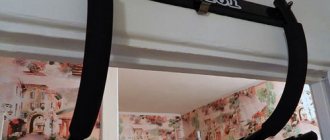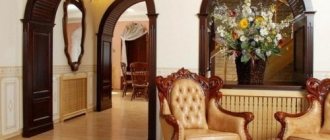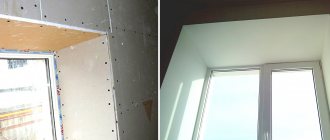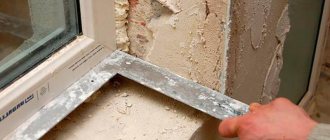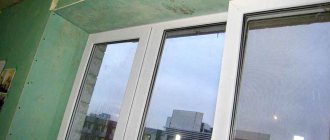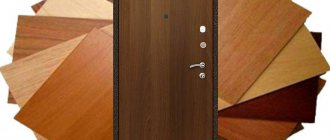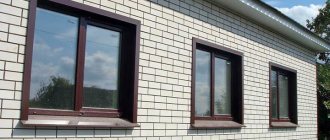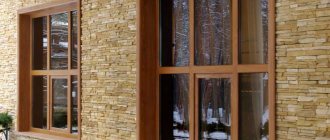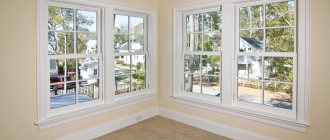Purpose of devices
External metal slopes for plastic windows are designed to protect polyurethane foam from ultraviolet radiation, precipitation, and being carried away by the wind.
If the foam is not covered, in a few years the material will be damaged, cold air will begin to enter the room, and the walls will become damp, increasing the risk of mold. After installation, it is necessary to install slopes on new windows; most often they are also plastic, less often metal. It is better to use metal to improve the interior. It is able to reliably and efficiently isolate the opening from external influences.
Metal slopes for plastic windows must be installed immediately. Many homeowners do not do this, believing that foam will cope without protection. This opinion is incorrect. The main reasons why installation is required immediately:
- Aesthetically, the structure looks unattractive; the façade of the building looks untidy.
- Polyurethane foam will deteriorate under the influence of sun, wind and precipitation.
Foam is not capable of acting as waterproofing; it must be protected from moisture, otherwise moisture will be absorbed and the window will freeze in cold weather. If for some reason the installation of metal slopes is not possible immediately, for example, the building is being renovated, the installed windows with fresh foam must be covered with at least plastic film until the slopes are installed.
Ready-made metal slopes
Why is it recommended to use metal for slopes?
To protect the polyurethane foam, you can use plaster mixtures, plastic panels, paints and varnishes; if the work is carried out indoors, drywall will do.
Metal slopes for the façade side of a building are most suitable, since this material does not burn, is resistant to any weather conditions, and if stainless steel is used, you do not have to worry about the corrosion process.
The plaster can crack, and when it comes into contact with a PVC frame, condensation often occurs, which harms the walls and the plaster itself, and can cause mold to form. Drywall is afraid of moisture and is destroyed by it, so it can only be used in a dry room; It is unsuitable for the street, as it quickly deforms from precipitation, swells and collapses. Plastic can be used: it is much cheaper than metal, but it is worth remembering that this material does not like temperature changes and becomes more fragile. The mechanical impact of wind can break such panels.
Metal slopes are usually made of galvanized steel: it does not rust and is not afraid of mechanical stress. The material is covered with a special protective layer of polymer on top. It not only preserves steel from the influence of nature, but also allows you to achieve a neat decorative appearance of slopes.
Material for slopes – galvanized steel
Advantages over other materials
There are several types of finishing materials, using which you can give the window opening a complete appearance. These are plaster, drywall, plastic and paint. But in terms of its technical characteristics, none of these materials can compare with metal slopes. When deciding how to make slopes, you need to study the characteristics of finishing materials.
The polymer layer of the steel slope protects the product from rust
When using plaster, you must be prepared for the fact that the plaster layer will crack over time. Moisture getting into the gaps between the window frame and the plaster layer can cause mold to appear.
Drywall as a finishing material for slopes is only suitable for interior work. Even GVLV brand drywall is not able to withstand the direct effects of precipitation. In a short time it will swell, lose its appearance and collapse.
The use of plastic panels for finishing external slopes leads to the fact that in the sun the plastic fades and acquires an unpleasant yellowish tint. And with a sharp drop in air temperature, the plastic becomes brittle and may lose its integrity after minor mechanical stress. Therefore, it is better to use plastic for finishing internal slopes, especially in the kitchen.
Metal slopes are not exposed to weather conditions
The advantages of metal slopes are obvious, since the material for their production is galvanized steel, which is covered with a protective polymer decorative layer at the production stage. This protects products from corrosion and rust.
Advantages and disadvantages of using metal slopes
Window areas are most often decorated with metal slopes, regardless of whether this is done for plastic windows or wooden structures. Therefore, you should carefully consider their advantages:
- The characteristics of the material are such that it can withstand all environmental influences. Any whims will not matter to him. It is also important to consider that the metal does not experience destruction due to mechanical stress. This is especially important in regions with harsh climates and frequent hail.
- Maintenance is not difficult. By choosing this option, you can be sure that the product will serve for many years. It only needs to be occasionally cleaned of accumulated dirt and wiped with a cloth.
Metal slopes do not require special care, you just need to wipe them occasionally
On a note! If you choose a plastic or putty option, you will have to make more efforts to preserve such coatings. PVC quickly loses its original appearance and becomes dirty. Putty (plaster) is subject to destruction, which leads to annual renewal of damaged areas. With metal it is much easier, even if the paint layer peels off, it is easy to restore (this makes it possible to change the appearance).
- The shape of the product creates an excellent three-dimensional frame. It is important to know that, if necessary, any option can be made. Difficulties can arise only with arched structures.
The material has practically no disadvantages. There is only a necessary condition - pasting with sealing tape. It plays the role of sound insulation. If you ignore this feature, then the first rain will make you think about remodeling.
Advantages
- Thanks to the properties of steel and a special coating, metal window slopes are reliably protected from rust.
- The service life is practically unlimited and exceeds the suitability of analogues by several times.
- Thanks to modern polymers, slopes do not have to be painted.
- Installation of metal slopes is easy and can be done by a beginner.
- Attractive appearance, which allows you to make the facade complete in terms of design.
- Atmospheric phenomena will not cause harm to the material.
- Metal window slopes can be made in various colors, which allows you to match them to any windows. They will suit both standard white or wooden windows and unusual solutions. It is possible to order the desired color and make an original design.
Despite the fact that metal is more expensive than similar options, it will pay for itself, since over time the slopes will not have to be changed. If you get tired of the design, you can always repaint the slopes in the color you want.
Pros and cons of the material
Despite the fact that external metal slopes are more expensive than other types of finishing, their positive qualities more than make up for this drawback:
they have a high degree of resistance to corrosion and rust;
Metal slopes are covered with a layer of galvanized steel
It is recommended to install noise-absorbing tape along with the slopes. The
disadvantages include the high cost and the presence of sound effects arising from drops or hail falling on their surface . This can be dealt with if you use a special noise-absorbing sealing tape when installing metal slopes.
Another disadvantage of a metal slope is the impossibility of installing it in arched openings.
Manufacturing nuances
The production of metal protection has been actively developing in our country since Soviet times. The technology is being improved, so each such product is reliable and has a long service life. Today, you can mainly find galvanized slopes, which are made from steel of the same name, resistant to corrosion processes. The inner side of the steel is covered with a layer of soil. A special polymer coating is applied on top of the product to enhance its strength. The structure resembles a metal tile or corrugated sheet: a layer of zinc guarantees protection against rust, and polymer powder paint prevents mechanical damage to the zinc.
The production of slopes occurs only after the completion of the measuring stage, because the width and height of the product must correspond to the opening from the inside and outside. The side segments, as well as the upper and lower parts, are simply cut out from a sheet of metal prepared in advance, focusing on the collected dimensional data. The optimal thickness of the steel sheet is also determined by the parameters of the opening, but also by the required degree of rigidity. Thin metal is more often used - no thicker than 0.55 mm.
Installation methods
The order in which a metal slope is placed will largely depend on the design requirements and features of the house. External elements are usually mounted in the opening in the following order:
- Using a sharp tool, remove bulging foam pieces and clear the area of construction debris, dust and dirt. All seams are treated with sealant. To do this, take a gun with silicone and walk along the perimeter of the opening. You can proceed to the installation of the slope itself only after the seams have completely dried.
- Now you need to install the window sill. It is placed on the bottom of the opening with foam. To prevent the ebb from bending due to the expansion of the foam, it is pressed tightly for a short time. The height of the ebb is regulated by spacers made of metal or wood. If the ebb is not horizontal, you need to set a level.
- The lower boundary of the intersection of the wall and the frame can be equipped with layers for additional thermal insulation and a diffuser tape, which will reduce noise levels and protect from condensation. After this, the ebb is screwed to the frame with self-tapping screws using fasteners for the corners.
- First, the side parts are fastened with self-tapping screws, taking into account the slope from the inside to the outside, and then the top bar is inserted, filling all the free space between the slopes and the wall with foam. The procedure for attaching all parts is the same: apply foam to the inside of the slopes and the opening. Do not forget to apply sealant to those places where the metal slope comes into contact with the frame. Lean one side of the slope against the pre-attached profile, the other against the wall.
- The sides are installed vertically, attracting them with screws, and the upper part is already mounted taking them into account, secured with self-tapping screws. Each joint area is again treated with sealant.
Preparing for installation
Careful preparation should always be done, no matter what the house is made of, brick, timber or concrete panels. Step-by-step instructions for preparation are as follows:
- The mounting foam is removed; it should be flush with the window frame. The work is carried out using a stationery knife.
- Next, you need to assess the condition of the walls and surfaces, and if necessary, eliminate all cracks, cracks or cracks with regular putty.
- Voids are not allowed between the base and the iron element.
- The joints and the surface itself are additionally treated with sealant. If the walls are made of brick or concrete, then before installing the finishing material on the slope, you should soak everything with an antiseptic, which will prevent mold from appearing.
All mixtures used must dry out, when the defects have been eliminated, then installation must begin.
Installation tool
Before installing metal slopes on windows with your own hands, prepare the necessary materials and tools for the job:
- Screwdriver with bits.
- Measuring tape and corner.
- Scissors for cutting metal.
- Hammer.
- Stationery knife.
- Spatula.
- Construction pistol.
The fastest way to install metal slopes is in new houses where there were no wooden windows. Otherwise, you need to prepare a place to work. It should be noted that the external slope should be done quickly, when the installed window frame can begin installation. Otherwise, the polyurethane foam begins to deteriorate, cracks appear, and in winter the window opening may freeze.
Metal slopes on external windows: step-by-step instructions
After installing PVC windows, the work does not end, because the house and the window opening need to be decorated.
By making external slopes for plastic windows from metal, you get an excellent appearance.
The work can be done with your own hands, the main thing is to follow the instructions step by step and also be careful. Windows make the facade of the house beautiful and decoration is an important part.
Basic functions of metal
What external metal slopes on windows look like
The metal slope for PVC windows is not just used for beauty; this design has several main functions:
- The window opening after finishing will be finished and visually beautiful. An arched metal window opening has a finished decorative look. There are standard design options and others that differ in design and color.
- Slopes made of metal profiles for windows protect joints and seams from environmental influences, for example, from wind, sun and precipitation. The seams will not collapse, and the window will last a long time.
- Due to the external metal slopes, excellent sealing is obtained; additional thermal insulation can be installed. When installing slopes without facing material, they will quickly collapse, cracks will appear, and the metal-plastic window frame itself will begin to let cold into the house.
As you can see, installing metal slopes on windows allows you to achieve not only a beautiful view, but also protects the house and the window from damage.
Pros and cons of metal slopes
Why do we need external metal slopes on windows?
Outside, metal is often used for slopes; it makes no difference which window is installed in the house, made of plastic or wood. Therefore, it is worth considering in detail the advantages and disadvantages of the material:
Advantages: Disadvantages:
| The metal slope can withstand various loads that come from the environment. | When using metal, you will need to glue additional tape for sealing, which absorbs noise. If you do not use it, then after precipitation you will need to remove the material and correct the slope. |
| The material is not damaged by mechanical impact, which is important in regions where hail often occurs. | The cost of metal is higher than that of other finishing materials, for example, plastic siding or putty, polymer. |
| Caring for the surface is simple and not difficult. It is enough to remove dirt from time to time with a rag or broom. | |
| Long service life. |
When choosing plastic for the slope or putty, it will take more effort during operation so that the slope is preserved and looks beautiful. PVC will quickly lose its appearance and will be constantly dirty. The putty quickly breaks down, due to which the window slopes are renewed every year or less.
Important! By choosing to finish the outside of windows with metal slopes, the work is easier, and the surface itself will last longer. Even if the paint peels off, the slope coating is easily restored.
The shape of the metal will allow you to create a three-dimensional window opening for any type of window. Difficulties when working with your own hands appear only when creating an arch.
Installation tool
Necessary tools for installing metal slopes
Before installing metal slopes on windows with your own hands, prepare the necessary materials and tools for the job:
- Screwdriver with bits.
- Measuring tape and corner.
- Scissors for cutting metal.
- Hammer.
- Stationery knife.
- Spatula.
- Construction pistol.
The fastest way to install metal slopes is in new houses where there were no wooden windows. Otherwise, you need to prepare a place to work.
It should be noted that the external slope should be done quickly, when the installed window frame can begin installation.
Otherwise, the polyurethane foam begins to deteriorate, cracks appear, and in winter the window opening may freeze.
Measurement of the structure
Common mistakes when measuring
Before making metal slopes on the windows from the outside, measurements are taken. Accurate measurements are the key to successful cladding. The size of each plot is measured separately. It would be a mistake to take measurements only along the top of the slope, at low tide.
This action leads to problems with the matching sizes of the profile parts; they may turn out to be larger or smaller than necessary, and the defects will need to be eliminated. Measurements are taken with a tape measure, after which the data is entered into a notebook. It is very convenient to use the scheme when you need to cover several windows at once.
Installation of metal slopes
Fastening external metal slopes
How to install external metal slopes on windows? To do this, you need to transfer the dimensions to metal siding or other steel material, cut everything out and make bends. The parts are cut out with metal scissors. Installation Guide:
- You need to trim from the drainage. The element is cut to the size of the window frame, 1 cm smaller is allowed. The outer section is cut to size, taking into account allowances for the wall. The side parts are made with an allowance of 1 cm. They are bent, the entire part should slope away from the window.
- The ebb tide is placed in the seat. Due to its shape, it will fit the side walls, moving slightly into the vertical plane. The element is screwed directly to the frame with self-tapping screws.
- Next, you need to trim the side part. They need to be placed vertically to cover the low tide sections. Installation is carried out using self-tapping screws.
- The last finishing element is the top piece. It fits the side parts and is equal to the outer corners. Must be mounted with self-tapping screws.
- According to the technology, all places are fixed with sealant, which will tightly close the adjacent parts.
Installation of metal slopes
Installing metal slopes on windows with your own hands is a simple procedure, but it requires care and attention. To work you will need a minimum set of tools:
- Screwdriver with a set of bits.
- Tape measure and square.
- Metal scissors.
- Hammer.
- Construction knife (stationery version).
- Spatula (if additional preparation is required).
- Construction pistol.
Tools required to install a metal slope
On a note! The installation process is fastest when the work is carried out in a new house where there were no wooden windows. Otherwise, it is necessary to provide a set of preparatory measures.
It must be taken into account that external work is carried out as quickly as possible. You cannot wait a long period of time after installing window frames. Many people mistakenly believe that work can be delayed during the summer. But the result of such inaction is destroyed polyurethane foam and microscopic cracks that have absorbed a lot of moisture.
Work on the installation of external slopes must be carried out immediately after installing window structures
Measurement of the structure
Common mistakes when measuring
Before making metal slopes on windows from the outside, measurements are taken. Accurate measurements are the key to successful cladding. The size of each plot is measured separately. It would be a mistake to take measurements only along the top of the slope, at low tide.
This action leads to problems with the matching sizes of the profile parts; they may turn out to be larger or smaller than necessary, and the defects will need to be eliminated. Measurements are taken with a tape measure, after which the data is entered into a notebook. It is very convenient to use the scheme when you need to cover several windows at once.
Stage two - preparation
Careful preparation is necessary for window openings whose adjacent walls are made of brick or concrete slabs. Such structures are subject to numerous falls and are covered with cracks. The following manipulations are performed:
- The polyurethane foam is cut off. It is removed flush with the window frame. This is done using a construction knife.
- The general condition of all surfaces is assessed. If required, cracks and holes are covered with putty.
- The formation of voids between the installed elements and the base must not be allowed.
- The surface and seams are additionally treated with sealant. It is best to soak concrete and brick surfaces with an antiseptic, this will prevent the appearance of mold.
It is necessary to give some time for the applied materials to dry.
Before installing metal slopes, it is necessary to restore the integrity of the coating
Step 3: Finishing the seams
It is very important that good thermal insulation of the room is achieved, and for this it is necessary to thoroughly treat all seams with sealant. So we pick up a gun with silicone and carefully apply it around the perimeter of the entire window. After drying, we do a visual inspection for the presence of untreated areas; there should not be any.
Stage three - installation
The dimensions are transferred to metal strips that have the necessary bends. Each element is cut using metal scissors. The technology is as follows:
- Finishing the slopes begins at low tide. This part is cut to the size of the window frame or less by one centimeter. The outer part is cut to the specified size of the opening, taking into account the allowance for the wall. The side parts are made with an allowance of one centimeter - they will need to be folded. The structure should be tilted away from the window.
- The ebb is installed in its place. It turns out that it fits the surface well, with its side walls extending into the vertical areas. It is screwed to the frame using self-tapping screws.
- Next, the side racks are installed. They are placed vertically, they must cover the curved sections of the ebb. Attached with screws.
- The top part is inserted last. It is adjusted to the installed side strips and aligned with the outer corners. Secured with self-tapping screws.
- Now you can apply sealant, which should reliably cover all adjacent areas of this structure.
Installation of metal slopes begins with the installation of low tide
It must be remembered that the sealing tape is pre-glued.
Thus, a beautiful and reliable cladding appears on the windows, which will play not only a decorative role, but also protect the surface from destruction.
External slopes made of metal, their advantages and installation tips
External metal slopes cover the untreated space between the window block and the wall. They are an excellent decorative element, but, first of all, they protect window structures from moisture during rain, snowfall or hail.
External metal slopes protect the mounting foam from direct sunlight, which contributes to the decomposition of the material. The installation of new windows or doors always ends with facing the slopes.
After dismantling the old window, the slopes are destroyed. From an aesthetics point of view, finishing the external slopes with metal or other material is necessary to complete the interior.
But this procedure is also necessary for high-quality thermal insulation of the window opening .
This is not how a slope should look!
Many owners of new windows put aside the work of finishing the slopes. They are visited by erroneous thoughts that nothing will happen to the windows yet, because they are reliably foamed. If you do not immediately begin work on installing metal slopes after installing the window unit, then, as a rule, the appearance of unfinished windows will remain for a long time.
Arguments that oblige the slopes to be finished immediately:
- As mentioned above, polyurethane foam quickly becomes unusable from sunlight.
- Foam is an excellent heat and sound insulating material.
But its waterproofing qualities are reduced to zero. Unprotected foam absorbs moisture, which also leads to its destruction. As a result, the metal-plastic structures of window blocks will freeze.
Remember that you can postpone finishing the slopes only until the renovation of the entire room or house is completed. To do this, cover the windows with plastic film and leave them like that until the general repairs are completed.
Why metal window slopes?
You can make window openings look decent by using the following materials: plaster, paint, plasterboard, plastic panels. But none of these materials can be compared with metal window slopes.
Plastering slopes from the outside has one advantage - it is cheap. Any plaster will crack over time. A gap appears between the plaster mixture and the PVC frame. This deficiency leads to the formation of condensation and then mold.
Traditional finishing of slopes with plasterboard is only possible on the inside of the room. Drywall cannot withstand high humidity. It swells, becomes deformed and loses its original characteristics.
Plastic panels lose strength from a sharp drop in temperature. Under certain mechanical stress they can easily break.
External metal slopes for windows are made of galvanized steel, coated with a protective layer of decorative polymer coating. This layer protects the metal from corrosion, the slopes do not rust and have a decent appearance.
Advantages of external slopes made of metal
- High resistance to corrosion.
- Long service life while maintaining original characteristics.
- No periodic painting required.
- Easy installation and subsequent maintenance.
- Decent appearance.
- Resistant to any weather conditions.
External metal window slopes have two main colors: white for white metal-plastic structures, brown for wood-laminated frames.
But individual orders in any color scheme are possible.
Metal slopes are more expensive than all other options, but they benefit from durability and ease of installation. Metal is easy to paint; the shade can always be changed at will.
Another interesting option is to decorate windows with siding yourself. This technology is described in detail in a separate article.
Read about installing internal plastic slopes here. We described various work technologies and added video examples.
Why do we need platbands for plastic windows? You will learn about this from this material https://balkonsami.ru/osteklenie/montazh-i-remont/nalichniki-na-plastikovyie-okna.html
Installation sequence
Before you begin installing external metal slopes with your own hands, each metal element in contact with the window frame is coated with silicone sealant. This action is necessary to protect the metal from moisture and preserve the thermal insulation properties of the insulation.
1. Installation of metal window slopes always begins with the installation of the lower element - the ebb. Its leveling is carried out by a level gauge. To ensure high-quality sound insulation, a special soft material can be placed under the ebb.
2. If you install the drip molding on mounting foam, then the latter is applied to the lower surface of the metal sheet and to part of the window opening. Next, the ebb is installed and screwed with self-tapping screws to the window frame. To prevent the lower slope from rising upward due to the expansion of the foam, it must be loaded evenly over the entire surface with something heavy.
3. Then the side slopes are installed. Since the bottom and top of any window opening slope from the inner edge to the outer edge, the top and bottom of each side slope must be trimmed depending on the angle of the bevel.
Therefore, only competent measurement of the window opening and high-quality trimming of metal sheets will make it possible to easily insert the side slopes into place without creating gaps at the joints.
After proper installation, the side slopes are attached to the window frame using self-tapping screws.
Advice: If you do not have the proper experience, then it is better to try making test cuts on paper. You will understand how to make this cut correctly and preserve the metal elements.
4. The top element is inserted last. The free space between the wall and the metal part is filled with polyurethane foam.
For people who are used to doing everything with their own hands, the work of installing external metal slopes will not seem difficult. This process will even become interesting and creative.
And in the video you can watch the installation process.
Source: https://balkonsami.ru/osteklenie/montazh-i-remont/naruzhnyie-otkosyi-iz-metalla.html
Why is it necessary to cover the polyurethane foam?
Despite the obvious advantages of installing external metal slopes, many homeowners delay this process for various reasons:
- Not enough time;
- On the advice of the craftsmen, paint over the foam;
- Insufficient financial resources;
- There is not enough experience to do it yourself, and inviting specialists is expensive.
But you need to know that polyurethane foam, if it is not protected, undergoes the following processes:
- Destruction due to exposure to sunlight.
- It loses its properties as a thermal and waterproofing material - saturation with moisture even by 5% reduces its ability to retain the internal heat of the house by half.
Therefore, mold and rot may appear on wooden windows, and metal-plastic structures will begin to freeze. The result of all this will be the replacement of windows and additional expenditure of money.
Finishing external slopes with metal with a polymer decorative layer has many positive aspects. The original color of the metal remains for several decades. Thanks to the existing protective polymer layer, the slope finishing elements do not rust and do not require periodic painting. They are easy to clean and also easy to install. Window-wall connections already sealed with mounting foam or sealing tape are reliably protected from external influences, as a result of which these materials retain their thermal insulation properties.
Dimensions and design
Since slopes are made individually, measuring each window or doorway, the parameters of the product can be very different. The same applies to the level of complexity of the design. However, the metal slope is always solid and exactly fits the measurements, so high protection of the seams from water and sun is guaranteed.
The following types of slopes may have an unusual design:
- For ventilated facades or siding facades. In this case, the slopes will have protruding elements and shelves for fastening.
- For a brick facade. The slope will have a Z-shape.
Slopes for different facade windows, for example, can have a width of 2-60 cm. The length varies from 10 to 300 cm. Standard lengths are 125 cm, 200 cm and 300 cm. The thickness of the metal varies from 0.4 to 0.8 mm.
Slopes for ventilated facades
In ventilated facade systems using various types of cladding, a slope with several fastening shelves and protruding elements is generally installed.
| Rice. 1. General view | Rice. 2. Dimensions |
Using a mounting strip, the metal slope is attached to the guides of the subsystem, under the cladding. The frame is made in such a way that after installation the offset ranges from 2-4 cm.
Slope for a brick facade
The simplest version is the Z-shape. Fastening is done through a fastening shelf or special inserts to the window structure; the side areas are filled with insulation or foam.
| Rice. 3. Design | Rice. 4. Dimensions |
Metal slope for siding facade
For siding facades, it is possible to use the same metal slopes as for ventilated facades, or a specialized version with hidden fastening.
| Rice. 5. Design | Rice. 6. Dimensions |
Measurement of the structure
Before making metal slopes on the windows from the outside, measurements are taken. Accurate measurements are the key to successful cladding. The size of each plot is measured separately. It would be a mistake to take measurements only along the top of the slope, at low tide.
This action leads to problems with the matching sizes of the profile parts; they may turn out to be larger or smaller than necessary, and the defects will need to be eliminated. Measurements are taken with a tape measure, after which the data is entered into a notebook. It is very convenient to use the scheme when you need to cover several windows at once.
Instructions for finishing with metal sheets
The process of installing metal slopes is not complicated, but it requires care and precision. To properly insulate a room from the street, it is practiced to place thermal insulation under the sheets.
The work is performed in the following sequence.
- The window opening is measured, and the sheets of metal are cut into strips. The strip for the lower part of the opening is cut with a small margin to form a water drain.
Measuring and adjusting the tide
This is what the edge of the low tide should look like
- The first part to be installed is the lower part - the ebb. It is screwed to the frame and has small overhangs on the side sections of the window opening. It is important that the ebb is diverted from the window.
- Side stripes are installed. They are pressed tightly against the surface of the opening and cover the curved parts of the ebb.
- At the final stage, the top strip is installed.
- To improve the insulating characteristics of the structure, sealant is applied to the joints of the strips.
Metal ebbs and slopes for windows and plinths
Metal ebbs for plinths and windows, door and window slopes. Manufacturing of moldings and metal profiles to order. Current price, delivery and installation.
Depending on the place of application, window sills and base sills are distinguished.
Window sills
Window sills are installed at the bottom of the window opening. Slopes are included with the ebb tides. They are mounted on the top and sides of the window opening.
These profiles protect the space between the main wall and the curtain wall (basement or vinyl siding) from water. They also give the facade a finished look and decorate it.
Ebb tides for the base
Base flashings are mounted above the base, for example, between vinyl and base siding. They protect the base and foundation from rainwater and close the gap between the panels and the base. Also, metal flashings are placed above the protruding elements of the facade - to protect them from rainwater.
Sometimes the building's base does not clearly stand out or is missing as a separate element. Then, to protect the foundation from water flowing down the wall, flashings are placed on the foundation. They differ from the base flashing in their smaller width. After all, the ebb on the foundation is not installed over a protruding plinth, but is simply attached to the wall.
| window sills and slopes | basement flashings | tides on the foundation |
Material for production
Metal ebbs and slopes are made of galvanized steel sheet with a polymer coating. The color most often chosen is white - then the window openings stand out better on the facade. White metal slopes and ebbs retain their whiteness longer than plastic ones. They are easier to clean - even abrasive dust is easier to remove from metal than from plastic. They are also stronger and hold their shape better.
But the good thing about metal ebb and flow is that their color can be matched to the color of the roof. After all, they are made from the same sheet as roofing materials. Both the strength and durability of metal ebb and flow are the same as that of metal tiles or corrugated sheets.
Low tide installation
The length of the ebb is greater than the width of the opening, this is done on purpose. The width of the window opening is transferred to the metal ebb panel with an allowance on the sides. Cut off, allowances are cut so that “ears” in the shape of a trapezoid and a triangle are formed at the edges, which will cover the corner of the opening. The trapezoids are bent upward.
After the casting is ready, it must be applied to the bottom of the opening. Before final fastening, a noise-absorbing tape is laid. It's easy to install. A piece of the required length is cut from the skein. Remove the protective paper from the adhesive side and apply the tape. The ends are brought to the side slopes. The tape has a high degree of adhesion to various surfaces (concrete, metal, etc.), the main thing is that there is no dust or debris on them. The tape cannot be painted or plastered, as it will lose its working properties.
Correct installation relative to the surface is checked by level. If the panel is warped, it is necessary to remove the warp with available materials. Any metal or wooden spacers are suitable for height adjustment.
Drill holes in the ebb, base. Fasten with self-tapping screws and dowels.
Sequence of work
Installation of metal slopes on windows involves carrying out measuring work. The width and height of the product will correspond to the internal and external parameters of the opening. The manufacture of the top, bottom and side metal elements is carried out by cutting them from a prepared metal sheet in accordance with the measurements obtained.
Scheme for trimming a metal slope
Scheme for trimming the lower metal ebb
Scheme for trimming the upper metal ebb
At the second stage of work, the installation of a low tide takes place, the horizontal position of which is controlled by the building level. The lower junction of the wall and the window frame is equipped with a special heat-insulating material and diffusion tape for noise reduction and moisture protection.
First you need to install the tide
When attaching the ebb, mounting foam is applied to the window opening and to the ebb from the inside. To prevent it from bending due to the expansion of the foam, it is pressed tightly for a while. After the ebb is fixed, the installation of metal slopes begins.
Before installing metal slopes, it is necessary to treat the places where they will come into contact with the window frame with sealant.
Metal slopes are secured with polyurethane foam
First, the side elements are installed, maintaining the required slope from the inside to the outside. The upper and lower parts are adjusted using a knife depending on the level of inclination.
The side elements must be installed in a vertical position and tightened with screws. The upper part is adjusted to the side elements. It is aligned with the outer corners and secured with self-tapping screws.
At the final stage, all contact areas are treated with sealant.
When installing slopes on a façade made of corrugated sheets, use horizontal lintels
If the façade of the house is covered with corrugated sheets, it is necessary to use horizontal lintels when finishing window openings. These are side shelves made of corrugated sheets, which are attached to the wall on one side and to a metal profile on the other. Steel trims give the façade completeness.
Metal
Let's look at how to make metal slopes on plastic windows.
This option is the most convenient. They are much easier to install than the plasterboard option. The disadvantage of such slopes is the high cost of materials and the fact that such slopes are not suitable for every wall design.
Metal slopes are made mainly in wooden houses. Wood is not stable, so plasterboard and plaster cladding will not work. Over a fairly short period of time, such slopes will crack.
Metal for such slopes is used no thicker than 1 mm; if you take thicker metal, it will be problematic to cut it with metal scissors. But using a grinder to cut parts will not be very convenient.
The technology for installing such slopes does not differ significantly from the installation of plastic panels. The sheets used for metal slopes are coated with powder paint. This provides them with durability, protection from sunlight, and protection from rust.
The sheets are sold ready-made; you just need to cut them to the required dimensions and secure them with self-tapping screws. They should be mounted on the sheathing, since fastening them to the wall will be problematic. The lathing is made of wooden planks up to 30mm thick. The material for slopes is used in different colors, so it is worth choosing screws to match the color of the slopes so as not to spoil their appearance.
We invite you to watch a video about how to install metal external slopes:
How to install metal slopes on plastic windows from the outside?
The decorative design of openings is very important, and one of the ways to do this is to install metal slopes on the windows with your own hands. Let us consider all the features of such installation, manufacturing, as well as the advantages and disadvantages of these materials.
Metal slopes - main functions
Even a novice builder knows the importance placed on slopes. Of course, no matter how beautiful, high-quality and expensive a window unit is, its appearance will immediately be lost against a shabby background.
Moreover, this applies to the interior and exterior decoration of the house, because everyone wants their home to look at least neat.
In addition, these elements can add some zest to the interior, especially since today they make custom-made metal window slopes, which have a three-dimensional shape and a wide variety of palettes.
However, this is far from their main function, because in addition to appearance, it is very important that the room is warm enough, and slopes are also responsible for this. They do not let cold into the house in the winter and do not release heat, thereby favorably influencing the creation of a microclimate in the room.
Also, do not forget that polyurethane foam is easily destroyed, and in order to avoid such a turn of events, you should not hesitate to install external slopes.
They also additionally insulate all microcracks and seams, which will contribute to better sealing of the room, and therefore will also play a significant role in providing thermal insulation.
Advantages and disadvantages of finishing metal openings
Metal window slopes have many advantages. Firstly, they have excellent strength characteristics, which cannot be underestimated, because they are used for outdoor work.
This means that they need to be resistant to any vagaries of weather: strong wind, rain, hail, snow, ultraviolet radiation, frost, heat, etc.
What they do great! Secondly, ease of operation also plays a significant role.
After all, in fact, you only have to invest money once and enjoy its excellent quality for several decades. And to make these slopes look like new, you just need to wipe them with a damp cloth.
Thirdly, thanks to the unique manufacturing technology, they have a three-dimensional shape and are an excellent decorative frame for each window.
In addition, the color range is very diverse, so even the most demanding clients should not have problems choosing the right shade.
Compared to a fairly wide list of advantages, the disadvantages of such slopes are very small. Among them is the impossibility of installation on arched openings.
And this despite the fact that they are made individually for each window, of absolutely any size and complexity.
And the second disadvantage is that if you do not use a special noise-absorbing tape during installation, during rain there will be a characteristic knocking sound caused by drops hitting the metal.
Metal slopes for windows - scope of application and manufacturing features
External slopes of this type are used both for the design of window and door openings, and are especially relevant for owners of private houses.
Due to the integrity of the structure, and that is exactly what it is, all dimensions are measured in advance with exceptional precision and are indicated during the manufacture of these elements; they reliably protect all seams from the penetration of moisture and ultraviolet radiation. Their use on the ground floors of houses is also very important.
As for the manufacturing features, a similar technique for external finishing of door and window openings was known back in Soviet times. However, today, with such rapid development of technology, it is clear that it has also improved a lot.
Modern slopes are made of galvanized steel, which itself has excellent characteristics, including corrosion resistance, which is so important, especially considering their specification. A special polymer coating is applied on top.
Thanks to it, such products have a very long service life and increased strength, which makes them so in demand.
Installation of metal slopes on windows - let's get to work
So, if the interior finishing work can still at least somehow wait, then with the exterior - every month counts. In order to prevent spontaneous destruction of the opening under the influence of the environment, we will try to master how to install metal slopes on windows.
Step 1: Taking measurements
Since they have a one-piece design and are made individually for each window, it is very important to take all measurements correctly.
Even a beginner can cope with this, because all you need to measure is the length, width and height of the window opening. In general, to solve this issue, all we need is a good tape measure.
It is more reliable if the manufacturer provides measuring services.
Step 2: Preparation
At this stage of work, no difficulties should arise either. Preparatory work consists of removing all bulging foam. This can be done either with a simple sharp knife or with a special construction knife.
We also clean the surface of all kinds of debris, dirt and residues of construction compounds. After which you can safely carry out the direct installation of metal slopes on the windows. And almost every owner has the tools needed for this work.
These are a screwdriver, self-tapping screws, cylinders with sealant (silicone) and polyurethane foam, as well as the slopes themselves.
Step 3: Finishing the seams
It is very important that good thermal insulation of the room is achieved, and for this it is necessary to thoroughly treat all seams with sealant. So we pick up a gun with silicone and carefully apply it around the perimeter of the entire window. After drying, we do a visual inspection for the presence of untreated areas; there should not be any.
Step 4: Installation of flashing and corners
Installation work begins with the installation of window sills. We apply foam to the lower surface of the opening and place the ebb itself on it. Its height can be adjusted with wooden or metal spacers.
If yours is not located horizontally, then you first need to set the level according to the beacons, and only then proceed with installation.
For the corners, we screw special fasteners to the window frame with self-tapping screws.
https://www.youtube.com/watch?v=IPTcUBm-Kz4
At this stage of work, do not forget to also use a building level, because not only the appearance, but also how quickly and efficiently the slopes themselves will be installed depends on how well the vertical and horizontal lines are maintained.
Step 5: Installation
We apply construction foam to their inner surface and part of the window opening. Next, we lean one side against the pre-attached profile, and the other against the wall of the house (the slopes are made in an L-shape). First of all, we attach the “sides”.
The top bar is first simply inserted into the seat, and then the free space between it and the wall is blown with foam. After this, the last element is installed, which closes the gap between the upper horizontal sheet and the wall of the house.
Thus, to install slopes for metal windows with your own hands, you do not need any special skills, and the work will not be dirty, but even interesting, especially for creative individuals who like to do everything on their own.
Source: https://beton-stroyka.ru/fasad/kak-postavit-metallicheskie-otkosy-na-plastikovye-okna-snaruzhi.html
COLORS OF METAL SCOPE
The cost of manufacturing products made of galvanized steel is calculated based on the size, as well as the chosen color. Products in standard colors according to the RAL catalog have a lower cost. Below are the standard colors.
| RAL 1014 | RAL 1015 | RAL 1018 | RAL 3003 | RAL 3005 |
| RAL 3009 | RAL 3011 | RAL 5002 | RAL 5005 | RAL 5021 |
| RAL 6002 | RAL 6005 | RAL 6029 | RAL 7004 | RAL 7005 |
| RAL 8017 | RAL 9002 | RAL 9003 | RAL 9006 |
Products whose color is not included in the list of standard colors are painted separately. Our company paints our products with powder paint, which has the highest protective properties.
Instructions on how to install external structures with your own hands
Now we will tell you step by step how to install metal slopes on plastic or other windows, and what needs to be done for this. After all the preparatory work and measurements, the process is divided into several stages:
- If the slopes are cut out yourself, then all measurements taken earlier are transferred to a sheet of metal, and the contours are cut out with special scissors.
- Preparing the opening for installation work:
- Trim off excess foam with a paint knife.
- Clean the opening from dust and dirt, treat it with an antiseptic to prevent the appearance of mold and mildew.
- If necessary, seal all cracks with plaster (find out how to seal seams and cracks when installing slopes with plaster and other methods here).
- Next, all seams are covered with sealant.
- The most critical stage is the installation of ebb and corners. How to install and secure them:
- The first step is to install the lower part - the ebb. It is leveled using a level gauge. To prevent the metal from making a strong noise when it rains, you should place noise-insulating material (noise-absorbing tape or a thin layer of polyurethane foam) under the part. Important: If the mounting foam, which is applied to the lower part of the ebb and a little on the base of the window frame, begins to lift the structure, you must evenly press down the ebb with something heavy along its entire length. Afterwards the part is screwed to the window frame with self-tapping screws.
- The side slopes are attached next. It should be remembered that the upper and lower parts have a slope from the inner edge to the outer, so the edges of the part are cut in accordance with the angle of contact with the ebb and the corners of the opening. At the same time, competent measurements and a neat cut will prevent the formation of cracks, and all slopes will fall into place. After precise installation, the side parts are attached to the window frame with self-tapping screws and a press washer.
- The last to be installed is the external cladding element, which is also secured with self-tapping screws. For better thermal insulation, all cracks are filled with polyurethane foam (find out in this article how to properly work with polyurethane foam when installing window slopes, and what to look for when choosing foam).
- Careful inspection of all joints and cracks, which are additionally filled with sealant (how and with what to seal the seams after installing the slopes?).
We invite you to watch a video on how to install external metal slopes with your own hands:
Installing metal slopes with your own hands is not particularly difficult, the main thing is accuracy in measurements and careful installation of this facade element, which, despite its relatively high cost, can last for decades.
Preparing for installation
Installing modern metal slopes on windows with your own hands will require the preparation of special materials and tools for this type of work:
- metal sheets;
- level;
- fasteners;
- mounting foam and silicone sealant;
- screwdriver and bits;
- painting knife;
- metal scissors;
- roulette
Excess polyurethane foam must be cut off.
Surface preparation consists of removing construction dust and contaminants from it. Excess polyurethane foam is cut off with a painting knife, and the seams and joints are treated with silicone sealant. Do-it-yourself installation of a metal slope on windows should be done after the seams have dried .
Photo gallery of finished works
Important! By choosing to finish the outside of windows with metal slopes, the work is easier, and the surface itself will last longer. Even if the paint peels off, the slope coating is easily restored.
The shape of the metal will allow you to create a three-dimensional window opening for any type of window. Difficulties when working with your own hands appear only when creating an arch.
Sources
- https://oknanagoda.com/okna/naruzhnye-metallicheskie-otkosy-na-okn.html
- https://otdelkagid.ru/vnutrennyaya/okna/naruzhnye-otkosy-iz-metalla.html
- https://balashiha.facade.ws/metallicheskie-otkosy.html
- https://ingener-pto.ru/2019/12/12/kak-otdelat-okno-snaruzhi-metallom/
- https://otdelkasam.ru/vnutrennyaya/okna/naruzhnye-metallicheskie-otkosy-na-oknah.html
- https://remoskop.ru/metallicheskie-otkosy-okna-ustanovka-svoimi-rukami.html
- https://mezhdveri.ru/29338-podrobnaya-instrukcziya-po-ustanovke-metallicheskih-otkosov-na-okna-ot-podgotovki-do-montazha-s-foto.html
- https://remoskop.ru/naruzhnyie-otkosyi-metall-ustanovka.html
- https://kvadratstroy.ru/metallicheskie-otkosy-naruzhnyie-otsinkovannye
- https://balkon4life.ru/osteklenie/okna/naruzhnue-otkosu-dlya-plastikovyx-okon/.html
- https://www.navesfasad.ru/remont/ustanovka-metalliceskih-otkosov-na-okna.html
- https://okcomfort.com/okna/otkosy/svoimi-rukami-naruzhnye.html
- https://okcomfort.com/okna/otkosy/metallicheskie-svoimi-rukami.html
Pros and cons of metal slopes
Outside, metal is often used for slopes; it makes no difference which window is installed in the house, made of plastic or wood. Therefore, it is worth considering in detail the advantages and disadvantages of the material:
| Advantages: | Flaws: |
| The metal slope can withstand various loads that come from the environment. | When using metal, you will need to glue additional tape for sealing, which absorbs noise. If you do not use it, then after precipitation you will need to remove the material and correct the slope. |
| The material is not damaged by mechanical impact, which is important in regions where hail often occurs. | The cost of metal is higher than that of other finishing materials, for example, plastic siding or putty, polymer. |
| Caring for the surface is simple and not difficult. It is enough to remove dirt from time to time with a rag or broom. | |
| Long service life. |
When choosing plastic for the slope or putty, it will take more effort during operation so that the slope is preserved and looks beautiful. PVC will quickly lose its appearance and will be constantly dirty. The putty quickly breaks down, due to which the window slopes are renewed every year or less.
Installation of metal slopes (video)
Important! By choosing to finish the outside of windows with metal slopes, the work is easier, and the surface itself will last longer. Even if the paint peels off, the slope coating is easily restored.
The shape of the metal will allow you to create a three-dimensional window opening for any type of window. Difficulties when working with your own hands appear only when creating an arch.
